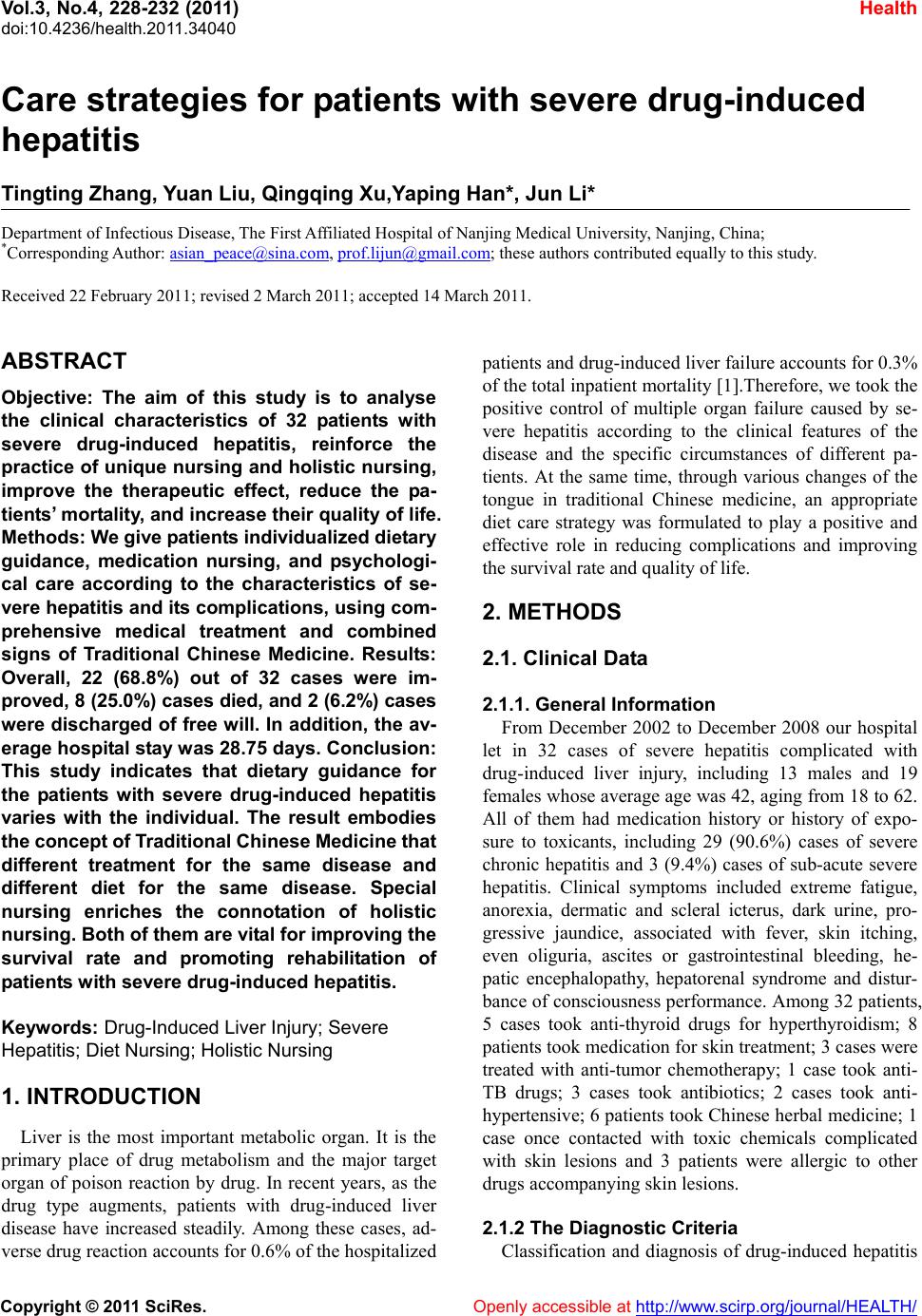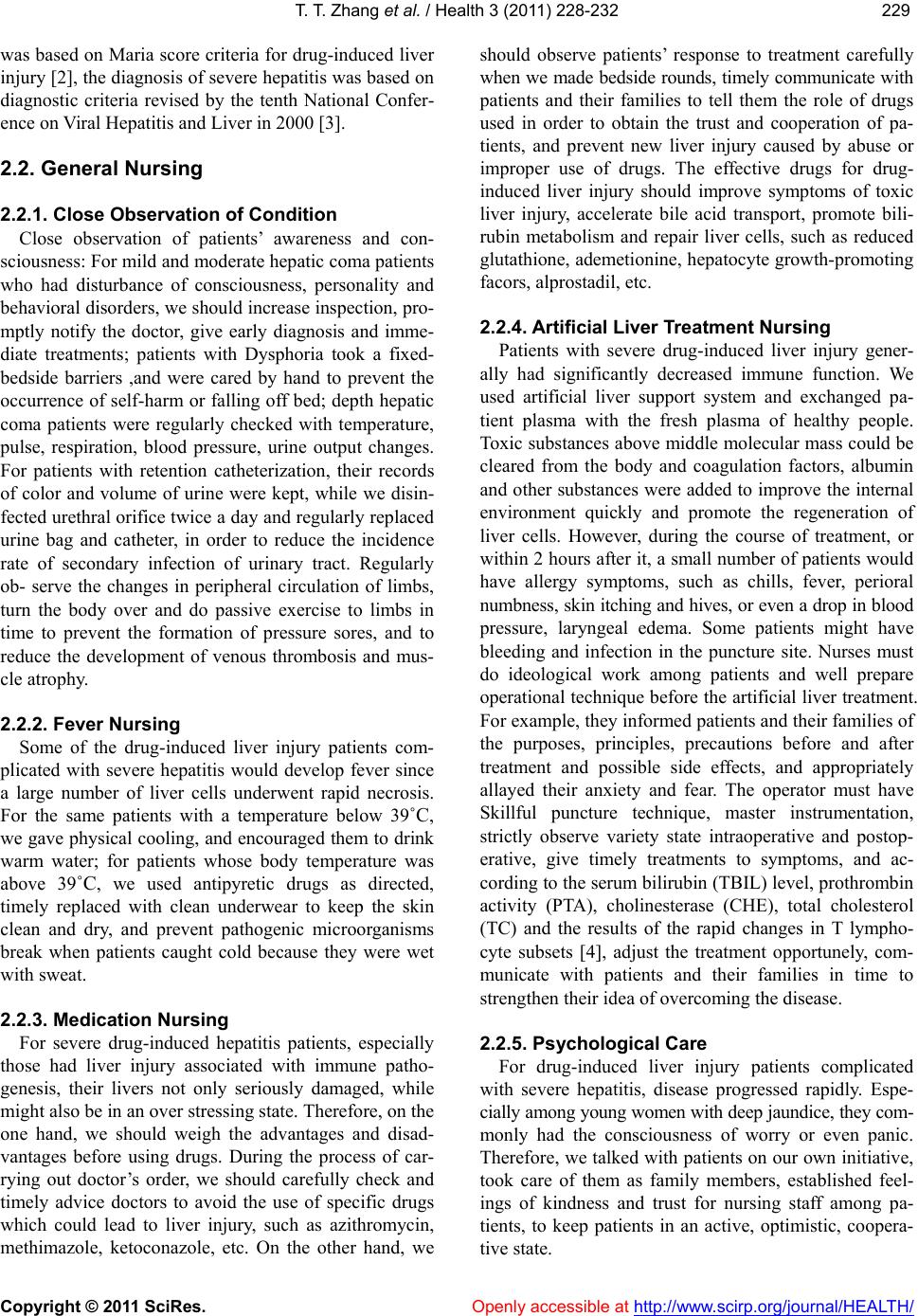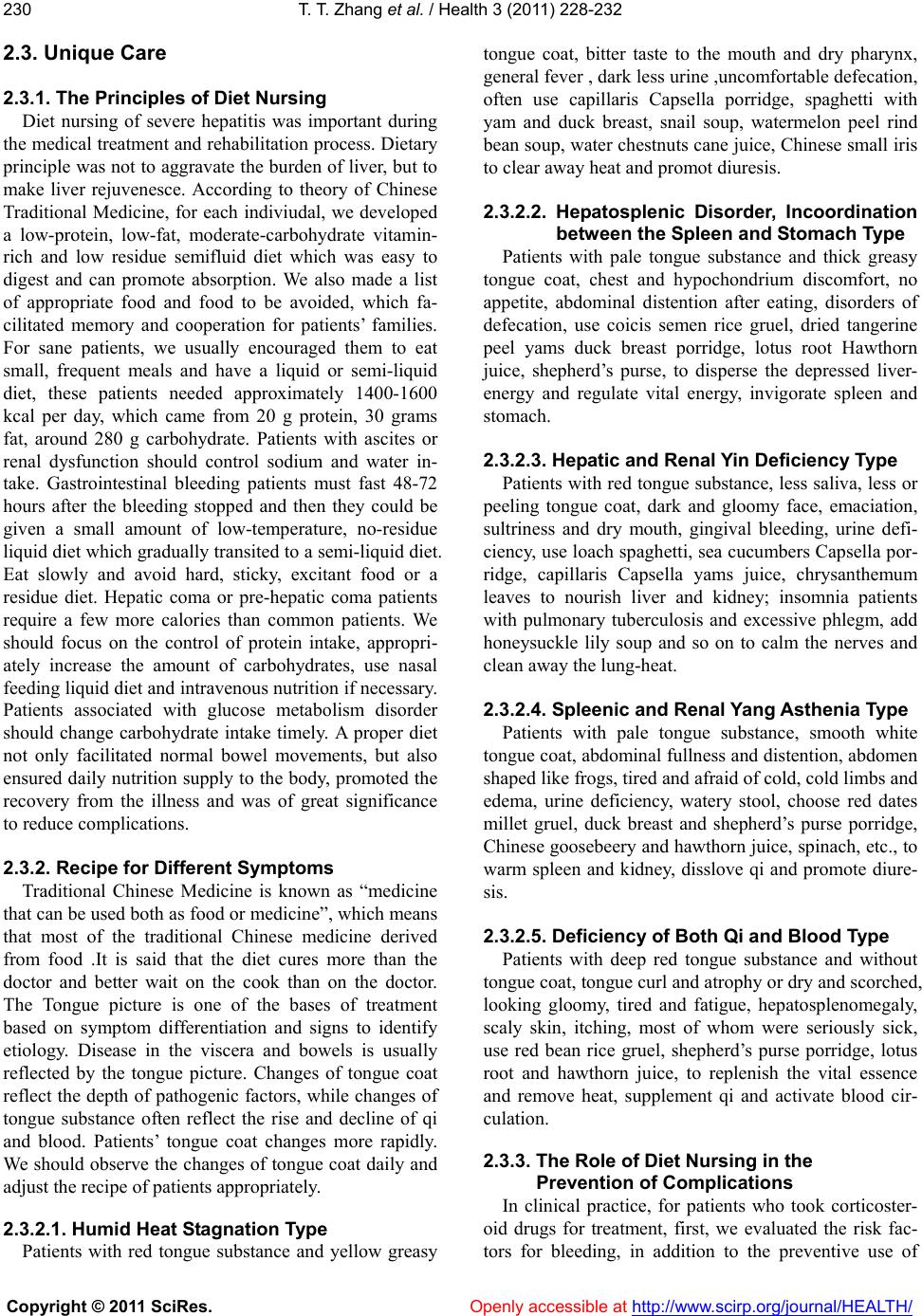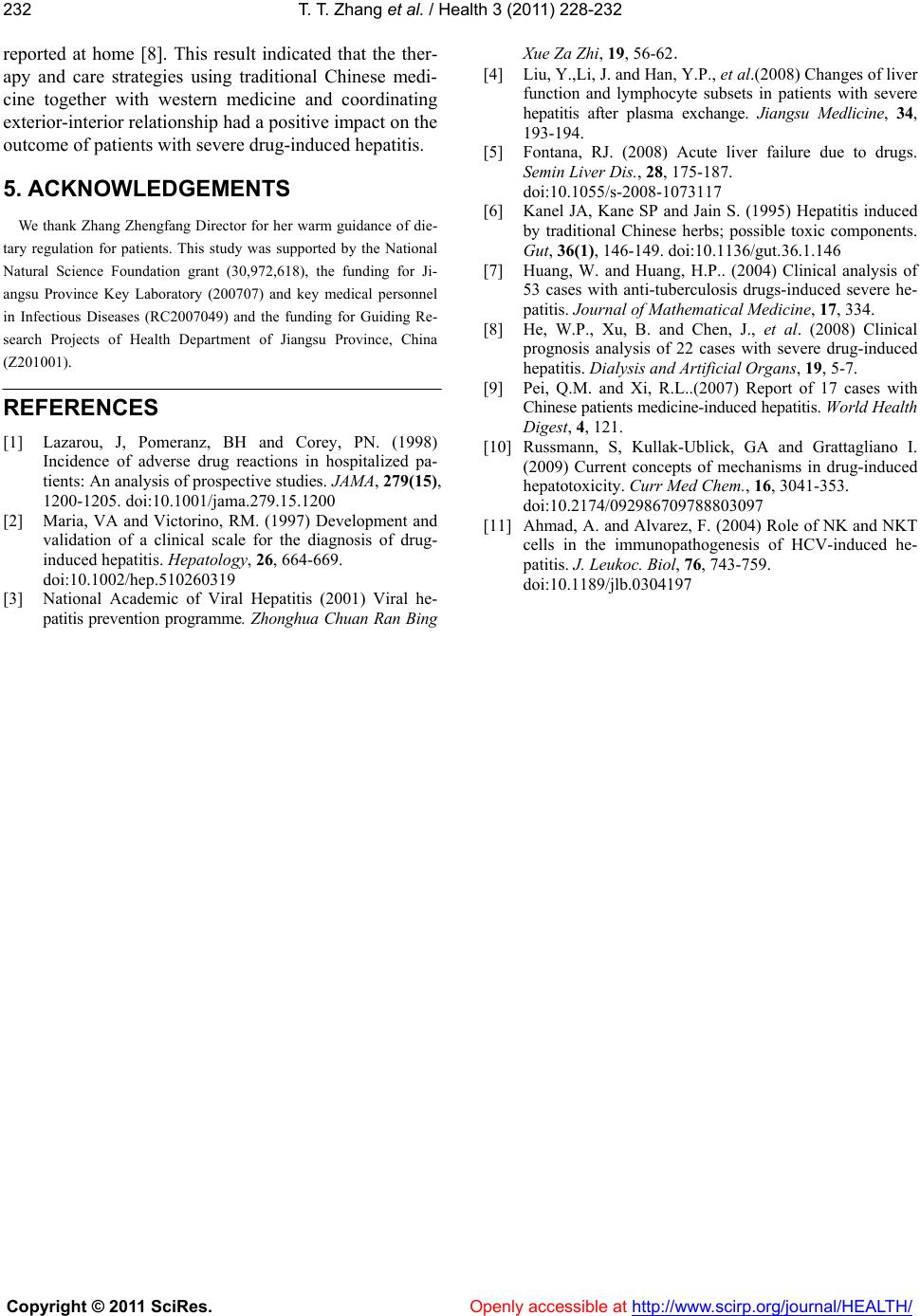Paper Menu >>
Journal Menu >>
 Vol.3, No.4, 228-232 (2011) Health doi:10.4236/health.2011.34040 Copyright © 2011 SciRes. Openly accessible at http://www.scirp.org/journal/HEALTH/ Care strategies for patients with severe drug-induce d hepatitis Tingting Zhang, Yuan Liu, Qingqing Xu,Yaping Han*, Jun Li* Department of Infectious Disease, The First Affiliated Hospital of Nanjing Medical University, Nanjing, China; *Corresponding Author: asian_peace@sina.com, prof.lijun@gmail.com; these authors contributed equally to this study. Received 22 February 2011; revised 2 March 2011; accepted 14 March 2011. ABSTRACT Objective: The aim of this study is to analyse the clinical characteristics of 32 patients with severe drug-induced hepatitis, reinforce the practice of unique nursing and holistic nursing, improve the therapeutic effect, reduce the pa- tients’ mortality, and increase their quality of life. Methods: W e gi ve patients indiv idualized dietary guidance, medication nursing, and psychologi- cal care according to the characteristics of se- vere hepatitis and its complications, using com- prehensive medical treatment and combined signs of Traditional Chinese Medicine. Results: Overall, 22 (68.8%) out of 32 cases were im- pro ved, 8 (25.0%) cases died, and 2 (6.2 %) cases were discharged of free will. In addition, the av- erage hospital stay was 28.75 days. Conclusion: This study indicates that dietary guidance for the patients with severe drug-induced hepatitis varies with the individual. The result embodies the concept of Traditional Chinese Med icine that different treatment for the same disease and different diet for the same disease. Special nursing enriches the connotation of holistic nursing. Both of them are vital for improving the survival rate and promoting rehabilitation of patient s with severe drug-induced hepatitis. Keywords: Drug-Induce d L iv er In ju ry; S eve re Hepatitis; Diet Nursing; Holistic Nur sing 1. INTRODUCTION Liver is the most important metabolic organ. It is the primary place of drug metabolism and the major target organ of poison reaction by drug. In recent years, as the drug type augments, patients with drug-induced liver disease have increased steadily. Among these cases, ad- verse drug reaction accounts for 0.6% of the hospitalized patients and drug-induced liver failure accounts for 0.3% of the total inpatient mortality [1 ].Therefore, we took the positive control of multiple organ failure caused by se- vere hepatitis according to the clinical features of the disease and the specific circumstances of different pa- tients. At the same time, through various changes of the tongue in traditional Chinese medicine, an appropriate diet care strategy was formulated to play a positive and effective role in reducing complications and improving the survival rate and quality of life. 2. METHODS 2.1. Clinical Data 2.1.1. General Information From December 2002 to December 2008 our hospital let in 32 cases of severe hepatitis complicated with drug-induced liver injury, including 13 males and 19 females who se aver age ag e was 42, ag ing from 18 to 62. All of them had medication history or history of expo- sure to toxicants, including 29 (90.6%) cases of severe chronic hepatitis and 3 (9.4%) cases of sub-acute severe hepatitis. Clinical symptoms included extreme fatigue, anorexia, dermatic and scleral icterus, dark urine, pro- gressive jaundice, associated with fever, skin itching, even oliguria, ascites or gastrointestinal bleeding, he- patic encephalopathy, hepatorenal syndrome and distur- bance of consciousness performance. Among 32 patients, 5 cases took anti-thyroid drugs for hyperthyroidism; 8 patients took medication for skin treatment; 3 cases were treated with anti-tumor chemotherapy; 1 case took anti- TB drugs; 3 cases took antibiotics; 2 cases took anti- hypertensive; 6 patients took Chinese herbal medicine; 1 case once contacted with toxic chemicals complicated with skin lesions and 3 patients were allergic to other drugs accompanying skin lesions. 2.1.2 The Diagnostic Criteria Classification and diagnosis of drug-induced hepatitis  T. T. Zhang et al. / Health 3 (2011) 2 28-232 Copyright © 2011 SciRes. Openly accessible at http://www.scirp.org/journal/HEALTH/ 229229 was based on Maria score criteria for drug-induced liver injury [2], the diagn osis of severe hepatitis was based on diagnostic criteria revised by the tenth National Confer- ence on Viral Hepatitis and Liver in 2000 [3]. 2.2. General Nursing 2.2.1. Close Observation of Condition Close observation of patients’ awareness and con- sciousness: For mild and moderate hepatic coma patients who had disturbance of consciousness, personality and behavioral disorders, we should increase inspection, pro- mptly notify the doctor, give early diagnosis and imme- diate treatments; patients with Dysphoria took a fixed- bedside barriers ,and were cared by hand to prevent the occurrence of self-harm or falling off bed; depth hepatic coma patients were regularly checked with temperature, pulse, respiration, blood pressure, urine output changes. For patients with retention catheterization, their records of color and volume of urine were kept, while we disin- fected urethral orifice twice a day and regularly replaced urine bag and catheter, in order to reduce the incidence rate of secondary infection of urinary tract. Regularly ob- serve the changes in peripheral circulation of limbs, turn the body over and do passive exercise to limbs in time to prevent the formation of pressure sores, and to reduce the development of venous thrombosis and mus- cle atrophy. 2.2.2. Fever Nursing Some of the drug-induced liver injury patients com- plicated with severe hepatitis would develop fever since a large number of liver cells underwent rapid necrosis. For the same patients with a temperature below 39˚C, we gave physical cooling, and encouraged them to drink warm water; for patients whose body temperature was above 39˚C, we used antipyretic drugs as directed, timely replaced with clean underwear to keep the skin clean and dry, and prevent pathogenic microorganisms break when patients caught cold because they were wet with sweat. 2.2.3. Medication Nursing For severe drug-induced hepatitis patients, especially those had liver injury associated with immune patho- genesis, their livers not only seriously damaged, while might also be in an over stressing state. Therefore, on the one hand, we should weigh the advantages and disad- vantages before using drugs. During the process of car- rying out doctor’s order, we should carefully check and timely advice doctors to avoid the use of specific drugs which could lead to liver injury, such as azithromycin, methimazole, ketoconazole, etc. On the other hand, we should observe patients’ response to treatment carefully when we made bedside rounds, timely communicate with patients and their families to tell them the role of drugs used in order to obtain the trust and cooperation of pa- tients, and prevent new liver injury caused by abuse or improper use of drugs. The effective drugs for drug- induced liver injury should improve symptoms of toxic liver injury, accelerate bile acid transport, promote bili- rubin metabolism and repair liver cells, such as reduced glutathione, ademetionine, hepatocyte growth-promoting facors, alprostadil, etc. 2.2.4. Artifici a l L iver Treatment Nursing Patients with severe drug-induced liver injury gener- ally had significantly decreased immune function. We used artificial liver support system and exchanged pa- tient plasma with the fresh plasma of healthy people. Toxic substances above middle molecular mass could be cleared from the body and coagulation factors, albumin and other substances were added to improve the internal environment quickly and promote the regeneration of liver cells. However, during the course of treatment, or within 2 hours after it, a small number of patients would have allergy symptoms, such as chills, fever, perioral numbness, skin itching and hives, or even a drop in blood pressure, laryngeal edema. Some patients might have bleeding and infection in the puncture site. Nurses must do ideological work among patients and well prepare operational technique before the artificial liver treatment. For example, they informed patients and their families of the purposes, principles, precautions before and after treatment and possible side effects, and appropriately allayed their anxiety and fear. The operator must have Skillful puncture technique, master instrumentation, strictly observe variety state intraoperative and postop- erative, give timely treatments to symptoms, and ac- cording to the serum bilirubin (TBIL) level, prothrombin activity (PTA), cholinesterase (CHE), total cholesterol (TC) and the results of the rapid changes in T lympho- cyte subsets [4], adjust the treatment opportunely, com- municate with patients and their families in time to strengthen their idea of overcoming the disease. 2.2.5. Psychological Care For drug-induced liver injury patients complicated with severe hepatitis, disease progressed rapidly. Espe- cially among young women with deep jaundice, they com- monly had the consciousness of worry or even panic. Therefore, we talked with patients on our own in itiative, took care of them as family members, established feel- ings of kindness and trust for nursing staff among pa- tients, to keep patients in an active, optimistic, coopera- tive state.  T. T. Zhang et al. / Health 3 (2011) 2 28-232 Copyright © 2011 SciRes. Openly accessible at http://www.scirp.org/journal/HEALTH/ 230 2.3. Unique Care 2.3.1. The Principles of Diet Nursing Diet nursing of severe hepatitis was important during the medical treatment and rehabilitation process. Dietary principle was not to aggravate the burden of liver, but to make liver rejuvenesce. According to theory of Chinese Traditional Medicine, for each indiviudal, we developed a low-protein, low-fat, moderate-carbohydrate vitamin- rich and low residue semifluid diet which was easy to digest and can promote absorption. We also made a list of appropriate food and food to be avoided, which fa- cilitated memory and cooperation for patients’ families. For sane patients, we usually encouraged them to eat small, frequent meals and have a liquid or semi-liquid diet, these patients needed approximately 1400-1600 kcal per day, which came from 20 g protein, 30 grams fat, around 280 g carbohydrate. Patients with ascites or renal dysfunction should control sodium and water in- take. Gastrointestinal bleeding patients must fast 48-72 hours after the bleeding stopped and then they could be given a small amount of low-temperature, no-residue liquid diet which gradually transited to a semi-liquid diet. Eat slowly and avoid hard, sticky, excitant food or a residue diet. Hepatic coma or pre-hepatic coma patients require a few more calories than common patients. We should focus on the control of protein intake, appropri- ately increase the amount of carbohydrates, use nasal feeding liquid diet and intravenous nutrition if necessary. Patients associated with glucose metabolism disorder should change carbohydrate intake timely. A proper diet not only facilitated normal bowel movements, but also ensured daily nutrition supply to the body, promoted the recovery from the illness and was of great significance to reduce complicatio ns. 2.3.2. Recipe for Different Symptoms Traditional Chinese Medicine is known as “medicine that can be used both as food or medicine”, which means that most of the traditional Chinese medicine derived from food .It is said that the diet cures more than the doctor and better wait on the cook than on the doctor. The Tongue picture is one of the bases of treatment based on symptom differentiation and signs to identify etiology. Disease in the viscera and bowels is usually reflected by the tongue picture. Changes of tongue coat reflect the depth of pathogenic factors, while changes of tongue substance often reflect the rise and decline of qi and blood. Patients’ tongue coat changes more rapidly. We should observe the changes of tongue coat daily and adjust the recipe of patients appropriately. 2.3.2.1. Humid Heat Stagnation Type Patients with red tongue substance and yellow greasy tongue coat, bitter taste to the mouth and dry pharynx, general fever , dark less urine ,uncomfortable defecation, often use capillaris Capsella porridge, spaghetti with yam and duck breast, snail soup, watermelon peel rind bean soup, water chestnuts cane juice, Chin ese small iris to clear away heat and promot diuresis. 2.3.2.2. Hepatosplenic Disorder, Incoordination between the S pleen and Stomach Ty pe Patients with pale tongue substance and thick greasy tongue coat, chest and hypochondrium discomfort, no appetite, abdominal distention after eating, disorders of defecation, use coicis semen rice gruel, dried tangerine peel yams duck breast porridge, lotus root Hawthorn juice, shepherd’s purse, to disperse the depressed liver- energy and regulate vital energy, invigorate spleen and stomach. 2.3.2.3. Hepatic and Renal Yin Deficiency Type Patients with red tongue substance, less saliva, less or peeling tongue coat, dark and gloomy face, emaciation, sultriness and dry mouth, gingival bleeding, urine defi- ciency, use loach sp aghetti, sea cucumbers Capsella por- ridge, capillaris Capsella yams juice, chrysanthemum leaves to nourish liver and kidney; insomnia patients with pulmonary tuberculosis and excessive phlegm, add honeysuckle lily soup and so on to calm the nerves and clean away the lung-heat. 2.3.2.4. Spleenic and Renal Yang Asthenia Type Patients with pale tongue substance, smooth white tongue coat, abdominal fullness and distention, abdomen shaped like frogs, tired and afraid of cold, cold limbs and edema, urine deficiency, watery stool, choose red dates millet gruel, duck breast and shepherd’s purse porridge, Chinese goosebeery and hawthorn juice, spinach, etc., to warm spleen and kidney, disslove qi and promote diure- sis. 2.3.2.5. Deficiency of Both Qi and Blood Type Patients with deep red tongue substance and without tongue coat, tongue curl and atrophy or dry and scorched, looking gloomy, tired and fatigue, hepatosplenomegaly, scaly skin, itching, most of whom were seriously sick, use red bean rice gruel, shepherd’s purse porridge, lotus root and hawthorn juice, to replenish the vital essence and remove heat, supplement qi and activate blood cir- culation. 2.3.3. The Role of Diet Nursing in the Prevention of Complications In clinical practice, for patients who took corticoster- oid drugs for treatment, first, we evaluated the risk fac- tors for bleeding, in addition to the preventive use of  T. T. Zhang et al. / Health 3 (2011) 2 28-232 Copyright © 2011 SciRes. Openly accessible at http://www.scirp.org/journal/HEALTH/ 231231 gastric mucosal protection drugs. Dietary regulation was of significance in preventing the occurrence of stress ulcer. We usually gave a small amount of high-quality low-protein, high-carbohydrate, low-fat semi-liquid or liquid diet to the patients; while for hepatic encephalo- pathy or pre-hepatic encephalopathy patients with high blood ammonia concentration, we not only strengthened the observation of the consciousness and awareness of patients, but also strictly limited the patients’ intake of animal proteins. We determined the supply of plant pro- teins according to clinical symptoms and ammonia lev- els, which was not only one of the most important meas- ures to control ammonia increase and to prevent hepatic encephalopathy, but also the key point of prognosis for patients who ha d alrea dy had hepati c coma. 3. RESULT Among all the 32 patients who had been treated, 10 were treated with the artificial liver support system, 3 patients who got skin lesions were treated with corticos- teroids, through a reason able diet nursing combined with immunological regulation and comprehensive treatment. No case had stress ulcer. As a result, in 22 (68.8%) cases we had seen improvements after treatment, in 8 (25.0%) cases the patients died, and in 2 (6.2%) cases the patients abandoned the treatment and discharged of free will. The average hospital days of stay were 28.75. 4. DISSCUSSION Drug-induced liver injury is an iatrogenic disease caused by drug or its metabolites. In the United States, the most common medicine that can cause severe hepati- tis is acetaminophen that belongs to antipyretic and an- algesic class [5]. In China, anti-tuberculosis drugs and Chinese herbal medicine are the most common cause [6-9]. In recent years, the number of drug-induced liver hepatitis cases increases rapidly [10] leading to the high concern of society. Liver has a special anatomy location, which undertakes internal blood filtation and external detoxification of intestinal products [11], especially, oral drugs which are absorbed via the gastrointestinal tract carry out biotransformation and metabolism in liver. Hence, drug concentration is significantly higher in liver than in blood and other organs. Poor Daily diet not only can impede rehabilitation but also has the potential of increasing the degree of liver injury, causing hepatic encephalopathy, upper gastrointestinal bleeding and other serious complications. Therefore, appropriate diet can provide proper nutrition to the body and promote the repair and regeneration of liver cells. Zhang zhongjing, the r enowned Chinese doctor of the Eastern Han Dynasty, said in “Synopsis of Golden Cham- ber”: “The taste of the food can help us get away from diseases, which can also be harmful to the body, if it is appropriate, it will benefit us, otherwise people will get sick.” Chinese classic work “Huang Di Nei Jing” also states: “Poison attacks evil, the five common cereals support us, five kinds of fruits help us, five kinds of animals benefit us, and five kinds of vegetables supple- ment us, eat when the taste of food is appropriate to re- plenish essence.” They indicated that improper food and drug intake are closely related to the occurence of dis- ease. There are more complications in patients with drug-induced severe hepatitis, and especially gastroin- testinal bleeding and hepatic encephalopathy are most common. For these patients, the diet principle developed by us was: combining patients’ tongue picture, select food that was rich in nutrition and had a effect of liver-protecting, lowering the transaminase, treating jaundice, preventing hemorrhage and hepatic coma. Moreover, the quantity of good quality protein which produced low nitrogen was limited, in order to improve hepatic steatosis, reduce nitrogen resources, and improve the immune function of patients; To improve patients’ appetite and ensure heat supply to body for patients whose jaundice had not resolved, it was recommended to use a small amount of vegetable oil in cooking and avoid fried food; consume carbohydrates in moderation to pro- mote the use of amino acids in liver; and sufficient vita- min supply to strengthen detoxification function of liver and help liver cells repair. In the early stage of disease, semi- fluid or soft rice which was easy to digest and nu- tritious was selected. During comvalescent stage, a nor- mal diet which was a less amount but had a good quality was chosen to reduce the burden of the liver as the pri- mary consideration. We made the use of the theory of symptoms differentiation related to traditional Chinese medicine, and developed personalized recipe for the pa- tients with drug-induced severe hepatitis. A rational and scientific diet not on ly could enhance the patients’ ab ility to resist disease, but also was of great significance to prevent gastrointestinal bleeding and hepatic encephalo- pathy. Our Traditional Chinese Medicine is extensive and profound, in clinical practice. With the reduction of pa- tient mortality and improvement of the life quality of patients as a starting point, we cooperated with medical workers, inspected personnel and multi-force. We took Western medicine as the main treatment which was sup- plemented by basic nursing, diet nursing, holistic nurs- ing and psychological care, and reinforced various as- pects to adjust immune function of patients, gradually restore the balance between entrails, qi and blood, yin and yang, so that the ineffective treatment rate of pa- tients in this group was significantly lower than the 63.6%  T. T. Zhang et al. / Health 3 (2011) 2 28-232 Copyright © 2011 SciRes. Openly accessible at http://www.scirp.org/journal/HEALTH/ 232 reported at home [8]. This result indicated that the ther- apy and care strategies using traditional Chinese medi- cine together with western medicine and coordinating exterior-interior relationship had a positive impact on the outcome of patients with severe drug-induced hepatitis. 5. ACKNOWLEDGEMENTS We thank Zhang Zhengfang Director for her warm guidance of die- tary regulation for patients. This study was supported by the National Natural Science Foundation grant (30,972,618), the funding for Ji- angsu Province Key Laboratory (200707) and key medical personnel in Infectious Diseases (RC2007049) and the funding for Guiding Re- search Projects of Health Department of Jiangsu Province, China (Z201001). REFERENCES [1] Lazarou, J, Pomeranz, BH and Corey, PN. (1998) Incidence of adverse drug reactions in hospitalized pa- tients: An analysis of prospective studies. JAMA, 279(15), 1200-1205. doi:10.1001/jama.279.15.1200 [2] Maria, VA and Victorino, RM. (1997) Development and validation of a clinical scale for the diagnosis of drug- induced hepatitis. Hepatology, 26, 664-669. doi:10.1002/hep.510260319 [3] National Academic of Viral Hepatitis (2001) Viral he- patitis prevention programme. Zhonghua Chuan Ran Bing Xue Za Zhi, 19, 56-62. [4] Liu, Y.,Li, J. and Han, Y.P., et al.(2008) Changes of liver function and lymphocyte subsets in patients with severe hepatitis after plasma exchange. Jiangsu Medlicine, 34, 193-194. [5] Fontana, RJ. (2008) Acute liver failure due to drugs. Semin Liver Dis., 28, 175-187. doi:10.1055/s-2008-1073117 [6] Kanel JA, Kane SP and Jain S. (1995) Hepatitis induced by traditional Chinese herbs; possible toxic components. Gut, 36(1), 146-149. doi:10.1136/gut.36.1.146 [7] Huang, W. and Huang, H.P.. (2004) Clinical analysis of 53 cases with anti-tuberculosis drugs-induced severe he- patitis. Journal of Mathematical Medicine, 17, 334. [8] He, W.P., Xu, B. and Chen, J., et al. (2008) Clinical prognosis analysis of 22 cases with severe drug-induced hepatitis. Dialysis and Artificial Organs, 19, 5-7. [9] Pei, Q.M. and Xi, R.L..(2007) Report of 17 cases with Chinese patients medicine-induced hepatitis. Worl d Health Digest, 4, 121. [10] Russmann, S, Kullak-Ublick, GA and Grattagliano I. (2009) Current concepts of mechanisms in drug-induced hepatotoxicity. Curr Med Chem., 16, 3041-353. doi:10.2174/092986709788803097 [11] Ahmad, A. and Alvarez, F. (2004) Role of NK and NKT cells in the immunopathogenesis of HCV-induced he- patitis. J. Leukoc. Biol, 76, 743-759. doi:10.1189/jlb.0304197 |

